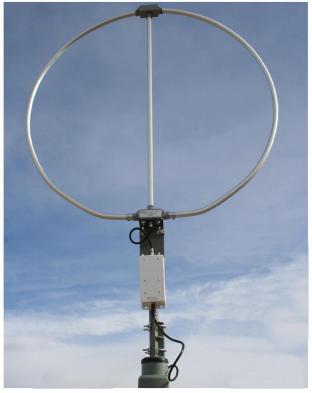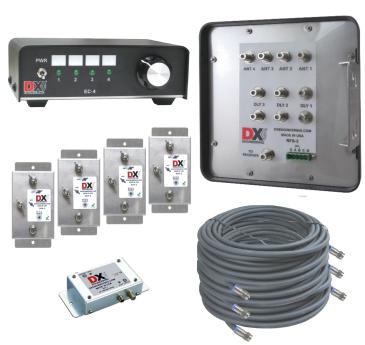Receiving weak stations with very low signal levels on frequencies from below the AM broadcast band up through the shortwaves of HF often requires the use of a specialized antenna system that improve the signal-to-noise ratio (s/n). This is simply explained by the statement: “You cannot understand an S-2 signal level below S-5 noise level.”In order to hear those weak stations, you’ll need to deal with the noise!

DX Engineering RF-PRO-1B Active Magnetic Loop Antenna
There are different approaches to mitigating noise. Most involve using some sort of receive-only antenna. One popular method is to use an Active Magnetic Receiving Loop (DXE-RF-PRO-1B). These directional antennas are extremely broad-band, easily covering the frequency range from 500 kHz to 30 MHz. Because they respond to the magnetic field as opposed to the electrostatic field of radio waves, they are inherently very quiet receiving antennas. Their loop mounted preamplifier powered by DC on the feedline is what makes “active” magnetic loop antennas boost their low-noise received signal.
Shortened verticals are popular SWL/AM DX/Amateur Radio receiving antennas (DXE-ARAV3-1P) for use over the same frequency range. Because of their physical length they “capture” less noise. These omni-directional receive antennas use special low-noise active preamplifiers to boost the low signals and their “amplifier” active circuit is mainly used to provide a broadband match to the feed line.

DX Engineering Receive Four-Square Array Electronics Package
Short verticals are ideal for use in a phased array known as Receive Four-Square array (DXE-RFS-SYS-3P) or 8-Circle arrays (DXE-RCA8B-SYS-4P), because these short antennas are very noise resistant. Vertical phased arrays produce a directional receive pattern with a peak lobe that can be “steered” away from the interference, and to steer the null in the pattern onto the QRN and QRM, so you can hear the desired signal.
It is also possible to use an active receive antenna as a “sense antenna” to deliberately collect noise and interfering signals and shift them out of phase with another receive antenna (or transmit antenna) to create a directional null or dip in reception. This is an extremely effective way of reducing or eliminating noise at the receiver. Phasing units are available with many different features and typically vary in price according to their features and effectiveness (DXE-NCC-1, DXE-NCC-2). It is possible to phase two active receive antennas with each other, or to phase a receive antenna with the received signal from a transmit antenna.
All of these suggestions involve use of receive-only signals. When you need to connect a receive antenna system to a transceiver equipped with a single antenna port, use a receive antenna interface unit (DXE-RTR-1A, RTR-2, NCC-2). These units allow automatic switching and protection for receive-only systems when you don’t have RX-only transceiver input.
Unlike 30 years ago, there’s no reason to be foiled by noise. Single, or even multiple methods, may be used to deal with unwanted noise. Then you can grab the weak ones!


Pingback: How to Boost Ham Radio Signal? - Ham Radio Planet